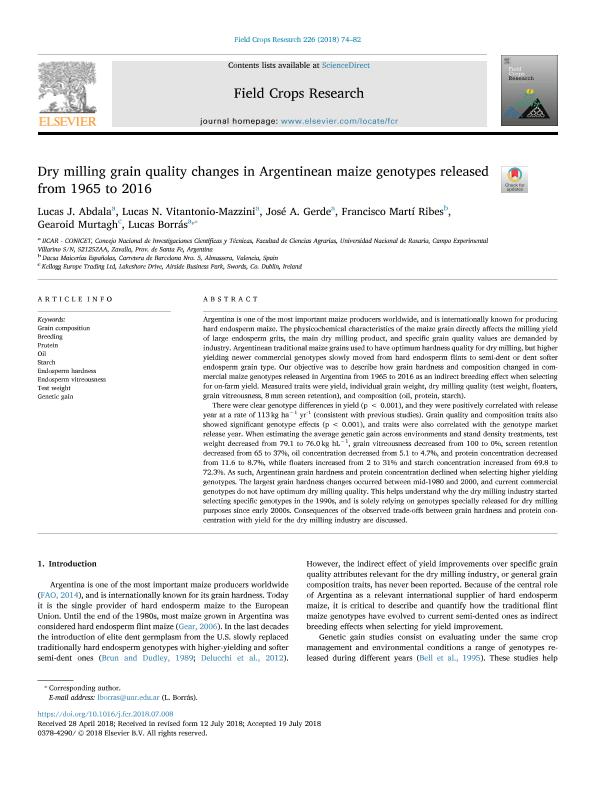Mostrar el registro sencillo del ítem
dc.contributor.author
Abdala Alonso, Lucas Jorge

dc.contributor.author
Vitantonio Mazzini, Lucas Nicolás

dc.contributor.author
Gerde, Jose Arnaldo

dc.contributor.author
Martí Ribes, Francisco
dc.contributor.author
Murtagh, Gearoid
dc.contributor.author
Borras, Lucas

dc.date.available
2023-01-27T15:52:51Z
dc.date.issued
2018-09
dc.identifier.citation
Abdala Alonso, Lucas Jorge; Vitantonio Mazzini, Lucas Nicolás; Gerde, Jose Arnaldo; Martí Ribes, Francisco; Murtagh, Gearoid; et al.; Dry milling grain quality changes in Argentinean maize genotypes released from 1965 to 2016; Elsevier Science; Field Crops Research; 226; 9-2018; 74-82
dc.identifier.issn
0378-4290
dc.identifier.uri
http://hdl.handle.net/11336/185949
dc.description.abstract
Argentina is one of the most important maize producers worldwide, and is internationally known for producing hard endosperm maize. The physicochemical characteristics of the maize grain directly affects the milling yield of large endosperm grits, the main dry milling product, and specific grain quality values are demanded by industry. Argentinean traditional maize grains used to have optimum hardness quality for dry milling, but higher yielding newer commercial genotypes slowly moved from hard endosperm flints to semi-dent or dent softer endosperm grain type. Our objective was to describe how grain hardness and composition changed in commercial maize genotypes released in Argentina from 1965 to 2016 as an indirect breeding effect when selecting for on-farm yield. Measured traits were yield, individual grain weight, dry milling quality (test weight, floaters, grain vitreousness, 8 mm screen retention), and composition (oil, protein, starch). There were clear genotype differences in yield (p < 0.001), and they were positively correlated with release year at a rate of 113 kg ha−1 yr-1 (consistent with previous studies). Grain quality and composition traits also showed significant genotype effects (p < 0.001), and traits were also correlated with the genotype market release year. When estimating the average genetic gain across environments and stand density treatments, test weight decreased from 79.1 to 76.0 kg hL−1, grain vitreousness decreased from 100 to 0%, screen retention decreased from 65 to 37%, oil concentration decreased from 5.1 to 4.7%, and protein concentration decreased from 11.6 to 8.7%, while floaters increased from 2 to 31% and starch concentration increased from 69.8 to 72.3%. As such, Argentinean grain hardness and protein concentration declined when selecting higher yielding genotypes. The largest grain hardness changes occurred between mid-1980 and 2000, and current commercial genotypes do not have optimum dry milling quality. This helps understand why the dry milling industry started selecting specific genotypes in the 1990s, and is solely relying on genotypes specially released for dry milling purposes since early 2000s. Consequences of the observed trade-offs between grain hardness and protein concentration with yield for the dry milling industry are discussed.
dc.format
application/pdf
dc.language.iso
eng
dc.publisher
Elsevier Science

dc.rights
info:eu-repo/semantics/openAccess
dc.rights.uri
https://creativecommons.org/licenses/by-nc-sa/2.5/ar/
dc.subject
BREEDING
dc.subject
ENDOSPERM HARDNESS
dc.subject
ENDOSPERM VITREOUSNESS
dc.subject
GENETIC GAIN
dc.subject
GRAIN COMPOSITION
dc.subject
OIL
dc.subject
PROTEIN
dc.subject
STARCH
dc.subject
TEST WEIGHT
dc.subject.classification
Agricultura

dc.subject.classification
Agricultura, Silvicultura y Pesca

dc.subject.classification
CIENCIAS AGRÍCOLAS

dc.title
Dry milling grain quality changes in Argentinean maize genotypes released from 1965 to 2016
dc.type
info:eu-repo/semantics/article
dc.type
info:ar-repo/semantics/artículo
dc.type
info:eu-repo/semantics/publishedVersion
dc.date.updated
2023-01-26T17:27:41Z
dc.journal.volume
226
dc.journal.pagination
74-82
dc.journal.pais
Países Bajos

dc.journal.ciudad
Amsterdam
dc.description.fil
Fil: Abdala Alonso, Lucas Jorge. Consejo Nacional de Investigaciones Científicas y Técnicas. Centro Científico Tecnológico Conicet - Rosario. Instituto de Investigaciones en Ciencias Agrarias de Rosario. Universidad Nacional de Rosario. Facultad de Ciencias Agrarias. Instituto de Investigaciones en Ciencias Agrarias de Rosario; Argentina
dc.description.fil
Fil: Vitantonio Mazzini, Lucas Nicolás. Consejo Nacional de Investigaciones Científicas y Técnicas. Centro Científico Tecnológico Conicet - Rosario. Instituto de Investigaciones en Ciencias Agrarias de Rosario. Universidad Nacional de Rosario. Facultad de Ciencias Agrarias. Instituto de Investigaciones en Ciencias Agrarias de Rosario; Argentina
dc.description.fil
Fil: Gerde, Jose Arnaldo. Consejo Nacional de Investigaciones Científicas y Técnicas. Centro Científico Tecnológico Conicet - Rosario. Instituto de Investigaciones en Ciencias Agrarias de Rosario. Universidad Nacional de Rosario. Facultad de Ciencias Agrarias. Instituto de Investigaciones en Ciencias Agrarias de Rosario; Argentina
dc.description.fil
Fil: Martí Ribes, Francisco. No especifíca;
dc.description.fil
Fil: Murtagh, Gearoid. No especifíca;
dc.description.fil
Fil: Borras, Lucas. Consejo Nacional de Investigaciones Científicas y Técnicas. Centro Científico Tecnológico Conicet - Rosario. Instituto de Investigaciones en Ciencias Agrarias de Rosario. Universidad Nacional de Rosario. Facultad de Ciencias Agrarias. Instituto de Investigaciones en Ciencias Agrarias de Rosario; Argentina
dc.journal.title
Field Crops Research

dc.relation.alternativeid
info:eu-repo/semantics/altIdentifier/doi/http://dx.doi.org/10.1016/j.fcr.2018.07.008
Archivos asociados
